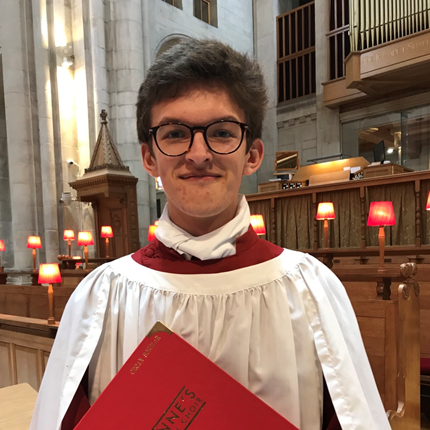
The next organ recital in this year’s series will be given by Mr William Forrest on Sunday 8 March 2020 at 4.15pm in
St Patrick’s Church of Ireland Cathedral, Armagh.
William is currently Organ Scholar at Belfast Cathedral, having previously been the James Junior Organ Scholar at St Martin in Roath, Cardiff. He took up the organ in 2012 under Oliver Hancock, soon after he had finished as a chorister and Head Chorister at Portsmouth Cathedral. He continued lessons with Robert Court whilst at University and currently studies with Matthew Owens.
William’s choice of music for this recital will include works by William Mathias, Buxtehude, J.S. Bach, Hindemith and Charles-Marie Widor. In explaining his choice of music, William said, “I chose to play Mathias’ ‘Fanfare’ to mark my three years at Cardiff University. Mathias composed the short but exciting piece for the inauguration of the Christie organ in the Memorial Hall in Barry, not far from Cardiff. The Welsh connection is also appropriate, given that St David’s Day is on 1 March, a week before my recital in Armagh.”
William continued,“Sandwiched in between late nineteenth and twentieth century works are three baroque pieces, two by J.S. Bach and one by Dietrich Buxtehude. Bach’s Fugue in B minor, BWV 579, uses a theme by Arcangelo Corelli. No-one is entirely certain when Bach composed the Fugue, though it may be from his time in Weimar between 1708 and 1717. Bach’s genius is evident in this rather sweet and calming fugue. This is also the case with the Largo from the Sonata in C minor, BWV 526, the second of Bach’s famously tricky trio sonatas. Probably composed once Bach had moved to the Thomaskirche in Leipzig, the movement displays Bach’s amazing ability to spin out a small amount of musical material, almost all of which is heard in the first 30 seconds of the movement, to create a whole movement.”
“The Danish/north German composer Dietrich Buxtehude had a major influence on the young Bach, who in 1705 famously walked 250 miles to hear and meet Buxtehude. Buxtehude’s Toccata in F, BuxWV 157 is typical of the music Bach walked that distance to hear, opening with a toccata in the ‘stylus fantasticus’, being followed by a fugue, a structure that Bach would use numerous times.”
William started performing the third movement of Widor’s ‘Symphonie Gothique’, the Allegro, in preparation for his final recital at Cardiff University. This was to coincide with his dissertation, which explored the use of various musical traditions in Widor’s Symphonies Gothique and Romane, the ninth and tenth organ symphonies that he composed.
In conclusion, William added, “Widor is generally only known for his Toccata from the Symphonie pour Orgue No 5. If you don’t recognise the title, you’ll most likely have heard the piece at a wedding. All of Widor’s organ compositions together only account for 10% of his total compositional output, and so this choice of piece was designed to explore some of his other compositions, with an aim to branch out into his other instrumental music in the future.”
Admission to the recital is free with a retiring collection most welcome towards the further endowment of the Cathedral choir through the Archbishop’s Choir Fund.